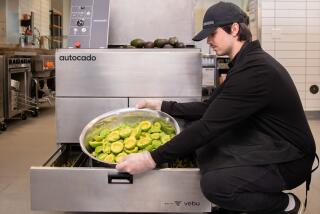Retail jobs are disappearing as shoppers adjust to self-service
- Share via
Automation — long a force in agriculture and manufacturing — is accelerating in the retail sector, a trend that could hamper efforts to bring down the nation’s stubbornly high jobless rate.
In an industry that employs nearly 1 in 10 Americans and has long been a reliable job generator, companies increasingly are looking to peddle more products with fewer employees. Shipping and warehousing workers are being replaced by robots that can process packages more efficiently than humans. Virtual assistants are taking the place of customer service representatives. Kiosks and self-service machines are reducing the need for checkout clerks.
Vending machines now sell iPods, bathing suits, gold coins, sunglasses and razors; some will even dispense prescription drugs and medical marijuana to consumers willing to submit to a fingerprint scan. And shoppers are finding information on touch screen kiosks, rather than talking to attendants.
Corona vending machine firm AVT Inc. is designing a fully automated gas station that will dispense gasoline, snacks, bottled drinks, even hot coffee with the swipe of a credit card — and not a single clerk. Some motorists may not like the concept; after all, these stations won’t have bathrooms. But AVT is betting that some filling station owners will love it. AVT’s smart vending machines don’t demand paychecks, call in sick or give incorrect change. They work 24 hours a day and give instant feedback on sales and inventory.
“It’s just like anything else that develops over time, with retail,” said Brentt Arcement, vice president of investor relations for AVT. “It’s sort of that evolutionary process of what’s next.”
In January, the U.S. employed 14.5 million retail workers, 1.1 million fewer than in January 2008. Although many of those job losses can be attributed to the Great Recession, experts said lean times have encouraged retailers to rethink their operations and figure out new ways to do more with fewer hands even as the economy improves.
Retail employment has barely budged over the last year despite stronger sales at major chains. Meanwhile, $740 billion was transacted through self-service machines in 2010, up 9% from 2009, said Greg Buzek, president of technology research firm IHL Group of Franklin, Tenn. He projects that will rise to $1.1 trillion by 2014.
That concerns some economists, including automation expert Martin Ford, who notes that low-skill retail jobs have become the employment of last resort for many Americans. Now it appears that even those positions could become less plentiful.
“We have a service economy, and the service sector is starting to automate,” Ford said. “We’ve seen that technology does destroy jobs in those sectors.”
The shift is as close as the corner store. Like gas stations and banks before them, supermarkets are encouraging patrons to avoid cashiers. Most major grocery chains have equipped their stores with a few self-service lanes, which research has shown boosts revenue and profits.
Shoppers at Fresh & Easy Neighborhood Market, a subsidiary of British retail giant Tesco, don’t have a choice — all checkout stations at the chain’s 156 U.S. outlets are do-it-yourself. Customers like the speed and shorter lines, said Brendan Wonnacott, a company spokesman.
“It’s part of being a modern grocery store,” he said. “And keeping our checkout process simple helps keep our costs low.”
Fresh & Easy customer Andre Najera said self-service machines make the checkout process faster — and less embarrassing when he is buying personal items that he’d rather not hand to a cashier. The Alhambra resident has become so adept that he now opts for machines over humans, even in stores that offer a choice.
“Sadly, it might be taking away someone’s job, but it’s much more efficient,” said Najera, a 36-year-old IT worker.
Others aren’t convinced. Bob Ebinger, 56, recently selected full-service at a Ralph’s in Hollywood, where he was buying a cartload of food and cat supplies.
“If you have as many items as I just bought, you would hold up the whole line bagging them,” he said.
Gains in productivity are vital for the long-term health of any economy. But in the short term, the weak labor market is tough on jobless retail workers such as Melanie Teter. The single mom and Orange resident has stocked shelves at Wal-Mart and sold Halloween costumes and party supplies at Party City. But despite submitting dozens of applications the last five months, she still hasn’t been hired.
“There are so many people applying for jobs,” she said.
Meanwhile, business is looking up at AVT, the Corona vending machine maker. The company posted revenue of $4.2 million through the first nine months of 2010, up 71% from the same period a year earlier. It also squeezed out net income of $50,000 after losing nearly $250,000 in the first nine months of 2009.
Some of the company’s kiosks look more like automated retail stores than traditional vending machines. What they sell is different too. Merchandise includes high-end electronics and cosmetics, available 24 hours a day in locations such as airports and hotels. The displays cost a fraction of brick-and-mortar stores. They also reflect changing consumer buying habits. Online shopping has made Americans comfortable with the idea of buying all manner of products without the help of a salesman or clerk; ATMs and electronic ticketing have reinforced the desire for instant gratification.
“We want things when we want them, how we want them, and we want them now,” AVT’s Arcement said.
How the trend plays out for America’s retail workers remains to be seen. Technological advance often destroys some jobs while creating others. Widespread adoption of smart phones, for example, has reduced the need for administrative assistants. But the technology has created new opportunities for app creators, programmers and others. Retailers said that adoption of technologies such as self-service checkout allows them to redeploy workers to more valuable tasks.
The nation’s standard of living rises when workers move up the job ladder and productivity increases, said Daniel Castro, a senior analyst with the Information Technology & Innovation Foundation, a think tank based in Washington, D.C.
“It’s not that when you don’t have an elevator operator there’s massive unemployment as a result,” he said. “It’s that people are freed up to do more valuable work.”
But advancing in a weak labor market is proving tough for Justin Brooks. The 29-year-old father of one managed a Starbucks outlet and has also worked at PetSmart and CVS. Despite 13 years of retail experience, more than half of them in management, he’s been out of work for more than six months.
He’s thought of going back to school, but he and his wife are already struggling to pay the bills. Their car was repossessed and they’ve moved to a smaller apartment to save on rent.
“First things first,” he said. “I need to find a job.”
More to Read
Inside the business of entertainment
The Wide Shot brings you news, analysis and insights on everything from streaming wars to production — and what it all means for the future.
You may occasionally receive promotional content from the Los Angeles Times.











